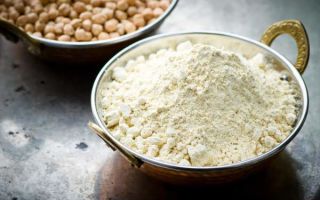Content
- 1 Composition and calorie content of chickpea flour
- 2 Useful properties of chickpea flour
- 3 What diseases is chickpea flour useful for?
- 4 The benefits of chickpea flour for weight loss
- 5 The use of chickpea flour in cosmetology
- 6 Face masks
- 7 Hair masks
- 8 Hair removal with chickpea flour
- 9 Chickpea flour scrub
- 10 How to make chickpea flour at home
- 11 What can be made from chickpea flour
- 12 Harm of chickpea flour and contraindications
- 13 How to store chickpea flour
- 14 Conclusion
- 15 Reviews
Chickpea flour is made from Turkish (lamb) peas - chickpea. This is a legume crop, predominantly widespread in the states of the Middle East. Chickpea dishes are very popular in Indian, Jewish, Turkish and many other cuisines. On the territory of Russia nakhat in different forms is only gaining popularity. The benefits and harms of chickpea flour will be discussed in this article.
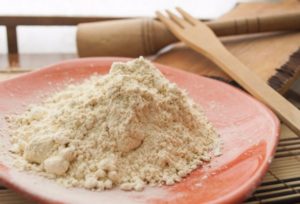
Composition and calorie content of chickpea flour
|
Composition |
amount |
|
proteins |
20 g |
|
fats |
3-5 g |
|
carbohydrates |
50-60 g |
The calorie content of flour from nakhat is about 360 kcal per 100 grams, but at the same time it will not harm. In terms of nutritional value, chickpea protein can be a complete alternative to animal protein and provides similar benefits.
The flour product is valuable for its high content of essential amino acids:
- methionine;
- lysine;
- tryptophan.
Due to its high protein content, pemphigus contains many purine bases, and also has a very high content of useful elements: K, Mg.
Made from lamb pea beans, the powder contains a large amount of phytosterols. They take part in the production of hormones and are part of the cell membranes. This property makes them a substitute for animal cholesterol, which has great benefits.
15% of carbohydrates in nakhat flour are water-insoluble fiber. Swelling, it becomes larger in volume, and this contributes to the feeling of satiety, in addition, it absorbs harmful substances in the digestive tract.
These useful properties of a chickpea product allow us to call it dietary.
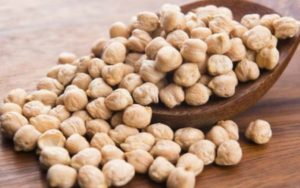
Useful properties of chickpea flour
Among the beneficial properties of chickpea flour, the absence of gluten should be highlighted. This is very important for people with intolerance to this substance. It is impossible to dispute the benefits of such flour for diabetics. The fact is that it has properties to lower the level of insulin, sugar and bad cholesterol, which reduces the risk of developing diabetes.
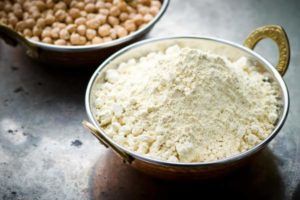
The product will be beneficial for other diseases as well:
- dermatitis;
- sclerotic abnormalities;
- autoimmune diseases;
- autism;
- attention deficit disorder.
In the olden days, ground beans were used to treat lung diseases. Now medical experts confirm the benefits of nahat flour for people with problems in the upper respiratory tract. It is necessary to prepare a stew from it, which should be regularly eaten. In addition, this product has prophylactic properties against cancer.
What diseases is chickpea flour useful for?
A huge list of useful properties of lamb peas allows you to use powder from it in the treatment of various diseases. In addition, it is recommended to add it to various dishes for such health problems:
- diseases of the central nervous system;
- diseases of the digestive tract;
- problems with the heart and blood vessels;
- decreased vision, cataracts and glaucoma;
- diseases of the musculoskeletal system;
- impotence in men;
- to normalize metabolism (with obesity, diabetes).
It is recognized that the soup made from crushed beans has the properties of helping the secretion of phlegm from the bronchi, therefore it is recommended for respiratory diseases.
The benefits of chickpea flour for weight loss
Chopped mutton peas are also beneficial for weight loss. Due to its low glycemic index, this product has an amazing dietary quality. Renowned nutritionists and fitness instructors unanimously recommend this product as a low-calorie meal.
The use of chickpea flour in cosmetology
There will be benefits from the use of chickpea powder for cosmetic purposes. This was practiced by girls in ancient India. And for the skin of the face, this product is especially useful. It is used to prepare cosmetic masks:
- brightening;
- for matting and cleansing the skin;
- with moisturizing properties.
Also, a healing agent can be found:
- as part of body scrubs;
- in cosmetics for scars, scars and against excess hair on the body.
Chickpea powder is also recommended for hair care: it does not harm them, but, on the contrary, brings shine and health. This tool is added to the composition of masks for hair and scalp, as it has many beneficial properties.
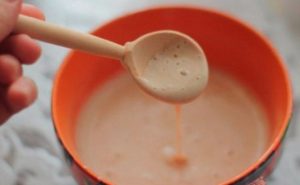
Face masks
Mask with cleansing and mattifying properties
Such a remedy will be especially useful for oily and problem skin of the face. Crushed chickpea fruits in combination with yogurt and raw milk are thoroughly mixed, the consistency should resemble thick sour cream. A mask is applied for 20 minutes. Then it is washed off with warm water.
Mask for scars and acne.
The flour must be mixed with a pinch of ground turmeric and 2 tablespoons of milk. Apply the mixture generously to the face and neck. Wash off with warm water after 25 minutes.
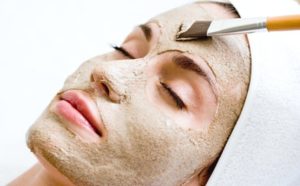
Hair masks
And the beneficial properties of ground chickpea will help your hair. It promotes strength, health and shine.
Shine mask
Composition:
- egg white;
- chickpea flour - 2 teaspoons;
- a teaspoon of cottage cheese;
- half a teaspoon of lemon juice.
Move all components and distribute along the length of the hair. Allow to dry, then rinse with cool water.
Long hair mask
- Mix a small amount of chickpea flour with ground almonds and cottage cheese.
- Add some olive oil to the mixture.
- It is also allowed to add 2 capsules of vitamin E.
- The mixture should be applied to the scalp and washed off with cool water after it dries.
It is recommended to carry out the procedure twice a week. If you follow the recipes, there will be no harm from this.
Hair removal with chickpea flour
You can also use ground bubble wort to remove excess facial hair. It is noteworthy that the result is fixed for a long time.
To do this, mix the bean and fenugreek powder to a paste. Apply the mixture to the required areas and wash off after drying.
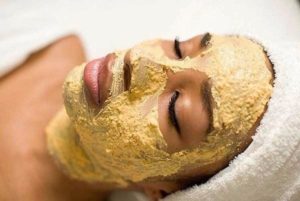
Chickpea flour scrub
- Mix 3 teaspoons of chickpea flour, a teaspoon of ground oatmeal and 2 teaspoons of cornmeal with a little milk.
- The mixture should be applied to the body with massage movements.
- Wash off with warm water.
This scrub will remove dead cells, excess sebum and dirt from the skin.
How to make chickpea flour at home
Making chickpea flour at home will require a blender or food processor.
- Lamb peas must be washed with water, dried overnight, or ignited in a preheated oven for 15–20 minutes.
- It is necessary to grind the fruits in small quantities to the state of flour.
Homemade chickpea flour should be stored in the refrigerator in a tightly closed container. In the freezer compartment, the shelf life will last up to a year.
What can be made from chickpea flour
Powdered nakhat is widely used in cooking.
- It can be used to make tortillas, breads, soups and cereals.
- In the East, bubbler flour is mixed with yogurt, water, milk, spices are added and fried in a hot frying pan.
- Sweet dough balls are also prepared from it - Lada, chickpea halva and other delicacies.
- This flour makes a very good breading for frying fish and meat. The chickpea product does not absorb oil, which reduces the harm from fried foods. Thanks to this property, the crust on the dishes is crispy, with a pleasant nutty taste.
- To replace 1 egg in the recipe, you need to mix a teaspoon of chickpea flour and the same amount of water.
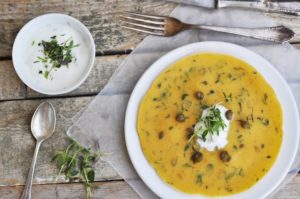
Harm of chickpea flour and contraindications
Lamb peas have a lot of useful properties, but this does not negate the possible harm from this product. It is not advised to use chickpea flour in such cases:
- with cholecystitis and thrombophlebitis;
- in case of inflammation in the digestive tract;
- jade and gout are also contraindications for eating chickpea flour.
The property of chickpea beans to provoke bloating and gas formation cannot be neglected.
How to store chickpea flour
It is recommended to store the nahat flour in a dry, dark and cool place. During storage of the product at a temperature of 0 ... 5 ° C in a tightly closed container, the beneficial properties will remain for about a year, and it can be used without fear of harm.
Conclusion
The benefits and harms of chickpea flour are not the same. The beneficial properties of bubble wort flour are truly amazing. The scope of its application is extensive. If we take into account the contraindications to the use of this product, then its effect on human health and well-being will only be positive.

